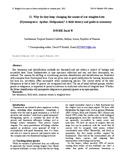Mostrar el registro sencillo del ítem
Why they keep changing the names of our stingless bees (Hymenoptera: Apidae; Meliponini): a little history and guide to taxonomy
| dc.rights.license | http://creativecommons.org/licenses/by-nc-sa/3.0/ve/ | |
| dc.contributor.author | Roubik, David W. | |
| dc.date.accessioned | 2013-05-02T16:31:53Z | |
| dc.date.available | 2013-05-02T16:31:53Z | |
| dc.date.issued | 2013-05-02T16:31:53Z | |
| dc.identifier.uri | http://www.saber.ula.ve/handle/123456789/36999 | |
| dc.description.abstract | Bee taxonomy and identification methods are discussed, then put within a context of biology and accessible data. Some fundamentals in type specimen collection and use, and species description, are outlined. The reasons for shifting or overturning previous classification and identification are illustrated with examples from Neotropical bees. Keys are given note as good justification for training taxonomists, as keys are, inevitably, often incomplete when considering species. The status of the tribe Meliponini is that at least 56 genera are recognized and used. The use of small, defined groups is important to permit an advance in study and collection of stingless bees. Whether the future classification will incorporate subgenera or primarily genera is an open question. | es_VE |
| dc.language.iso | es | es_VE |
| dc.rights | info:eu-repo/semantics/openAccess | |
| dc.subject | Bee taxonomy | es_VE |
| dc.subject | Field work | es_VE |
| dc.subject | Museum research | es_VE |
| dc.subject | Stingless bees | es_VE |
| dc.title | Why they keep changing the names of our stingless bees (Hymenoptera: Apidae; Meliponini): a little history and guide to taxonomy | es_VE |
| dc.type | info:eu-repo/semantics/bookPart | |
| dc.description.email | ROUBIKD@si.edu | es_VE |
| dc.subject.departamento | Departamento de Análisis y Control | es_VE |
| dc.subject.facultad | Facultad de Farmacia y Bioanálisis | es_VE |
| dc.subject.thematiccategory | Medicina y Salud | es_VE |
| dc.subject.tipo | Monografías | es_VE |
| dc.type.media | Texto | es_VE |


